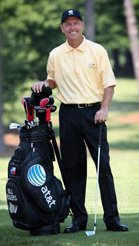TUESDAY, NOVEMBER 21, 2017
In 1981, Bill Rogers won the Open Championship at Royal St. George’s and went on to become the PGA Tour’s Player of the Year. Late in the 1980s, the rigors of the road brought Rogers back to his native Texas, where he settled in as a club professional in San Antonio. He still travels for golf’s sake, though less frequently and without the competitive pressure. We asked this genial ambassador of the game for some tips on playing a course for the first time.
What are some ways you can help us navigate our way around a course we’ve never played before?
“First of all, a lot of times having not seen a golf course actually works in your favor, the fact that you don’t know where the trouble is or you’re not in so much fear of what you do know—which is kind of an interesting dynamic about the game. Sometimes people play their best rounds on unfamiliar territory.
“There is so much information that you have the potential to get before you arrive at a golf course, so much so you could have played it in your mind, with all the internet access and different resources to get information about the golf course. That could or could not be a good thing.
“If I was really wanting to know about the golf course, I would seek out the golf course superintendent or the club professional and ask about any nuances of the golf course. Usually that pertains to elevation change in the golf course that isn’t exactly evident. Maybe the whole golf course drains toward the tenth green or something like that. Ultimately it can be helpful in reading putts or club selection.
“Another thing I would want to know, where the superintendent could be of help, is to indicate worrisome blind shots. That might be the most troublesome issue. You have a lot of that in Europe. People go over there and they don’t know how to deal with blind, and that can be really troublesome.”
Are there general things to keep in mind? Maybe I should be thinking that on most courses, the most severe trouble is beyond the green, that kind of thing?
“This would probably be the classic exercise in overthinking this. Golf really does boil down to one shot at a time—a tee shot to a particular point and then an approach shot and then hopefully being good around the greens. That’s usually going to be the simplicity of the deal. The more you make of it, the more anxiety you have about it being a new course, and all the things that go into playing a round of golf, I think you probably ought to be more careful to just relax, breathe out, and be aware of being the best you can on each one of your shots.”

